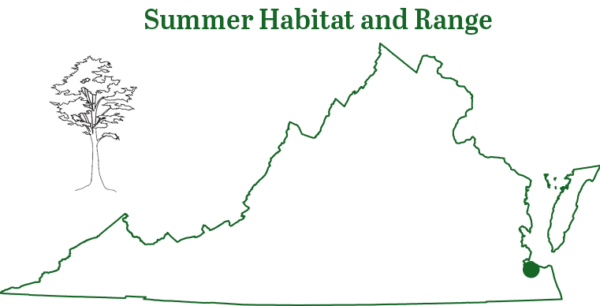Northern Yellow Bat. © Merlin D. Tuttle, Bat Conservation International.
Northern Yellow Bat. Illustration by Brittany Fernald.
Fact File
Scientific Name: Lasiurus intermedius
Classification: Mammal, Order Chiroptera
Identifying Characteristics
The northern yellow bat is a large tree bat with soft yellow-orange to yellow-brown fur. The tail membrane is only furred on the basal half and, unlike the other Lasiurus bats, the northern yellow bat lacks the white shoulder and wrist patches. The northern yellow bat weighs from 0.5–0.7 ounces and measures 4.6–5.1 inches in length.
Diet
They are known to feed in groups after the young begin to fly, and they prefer to feed in open areas. Hoppers, damselflies, flies, beetles, and winged ants are some of the insects northern yellow bats feed on.
Distribution:
The northern yellow bat is closely tied to the range of Spanish moss and is essentially restricted to the southern Atlantic seaboard. This species tends to favor oak and long-leaf pine stands that support large clumps of Spanish moss.
Typically, the sites are close to water and open areas where these bats feed. The northern yellow bat is not associated with caves or human structures like several of the other bats found in Virginia. There is only one record of the northern yellow bat in Virginia; a pregnant female was found in the tidewater area in 1954.

Maternity
Like other tree bats, the northern yellow bat has two to four young born in late May to early June. Mating probably occurs in the fall and winter. The northern yellow bat is typically a solitary species, but females sometimes form small maternity colonies.
Conservation
Occurs only incidentally in Virginia.
Last updated: August 14, 2024
ShopDWR
Order your copy of A Guide to the Bats of Virginia, along with more gear, guides, and gifts!
Visit ShopDWRThe Virginia Department of Wildlife Resources Species Profile Database serves as a repository of information for Virginia’s fish and wildlife species. The database is managed and curated by the Wildlife Information and Environmental Services (WIES) program. Species profile data, distribution information, and photography is generated by the Virginia Department of Wildlife Resources, State and Federal agencies, Collection Permittees, and other trusted partners. This product is not suitable for legal, engineering, or surveying use. The Virginia Department of Wildlife Resources does not accept responsibility for any missing data, inaccuracies, or other errors which may exist. In accordance with the terms of service for this product, you agree to this disclaimer.

